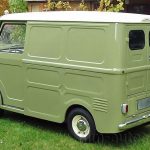Glas, Dingolfing, and Goggomobil. Goofy words that all describe a strange time of automotive freewheeling.
 In the 1950s and 60s, automotive design and markets were in a renaissance. The world wars were over and just about anyone who could raise enough capital could start a car company and find a niche to sell into. Goggomobil was one of those companies.
In the 1950s and 60s, automotive design and markets were in a renaissance. The world wars were over and just about anyone who could raise enough capital could start a car company and find a niche to sell into. Goggomobil was one of those companies.
Known mostly for its quirky small cars, the Bavarian company was based in the town of Dingolfing and had been founded by Hans Glas. The Goggomobil platform produced several micro and compact cars that had moderate success in parts of Europe.
Then the German postal service put out for bids for a new postal delivery and transport vehicle. Goggomobil jumped at the chance and the TL (aka Transporter) was born. The German post purchased over 2,000 of the Transporters and the public purchased even more. A special model made to clear U.S. road requirements was also produced, but not too many were sent here.
Most of the Transporters made were TL-250 models, which utilized a 247cc two-stroke rear-mounted, straight-twin, air-cooled engine and a four-speed manual transmission. The van measured 114.6 inches in length with a 70.9-inch wheelbase. A short truck version was also produced. The Americanized version TL-400 model was the same, but with a larger 392cc engine that included an automatic gas-oil mixer.
The Goggomobil Transporter had sliding front doors, double back doors (or tailgate if pickup version). The pickup model sold well as a municipal workhorse for street sweeping, snow plowing, and road repair trucks.
Today, the Transporter is highly collectible with only a few models still in existence. These odd-looking, goofy vans were nevertheless very versatile and useful back in the day. Even with the weird name.
Photos courtesy of Film-Autos.com and RM Sothebys.
Here is video of one in action:









